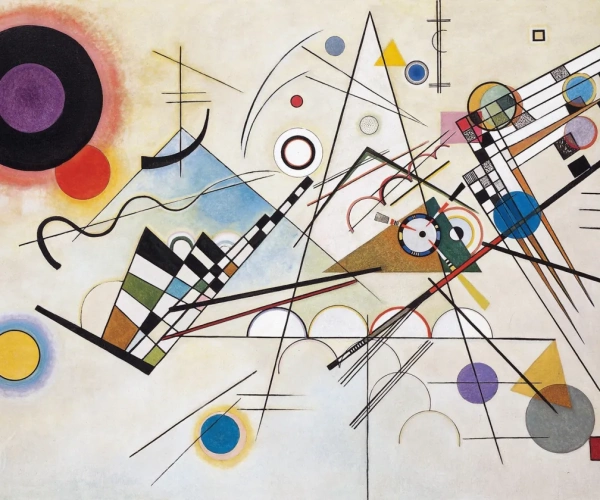Composition VIII
Wassily Kandinsky's "Composition VIII," created in 1923, stands as a monumental work in the annals of abstract art, encapsulating the radical innovation and philosophical depth of Kandinsky's vision. This masterpiece diverges significantly from the representational tradition, embarking on a journey that explores the intrinsic properties of color, form, and line. Kandinsky, often hailed as a pioneer of abstract art, believed in the spiritual and emotive power of these elements, seeing them as conduits to a higher aesthetic and existential understanding.
"Composition VIII" is a symphony of geometric forms, a visual language that Kandinsky meticulously developed. The canvas is a vibrant, complex network of circles, triangles, and lines, each element carefully placed to create a dynamic equilibrium. This equilibrium is not just a matter of visual balance but also an embodiment of Kandinsky's quest for spiritual harmony. The painting's geometric precision suggests a cosmic order, an unseen structure underlying the apparent chaos of the universe. This complexity is further enriched by Kandinsky's use of color. He ascribed specific emotional and spiritual values to colors, using them to evoke particular moods and ideas. In "Composition VIII," the interplay of warm and cool hues, the contrasts and harmonies, all serve to create a visual experience that transcends mere optical perception.
The work is also reflective of the broader cultural and intellectual currents of its time. Created in the Weimar period, a time of significant artistic and philosophical ferment, "Composition VIII" resonates with the ideas of Bauhaus, where Kandinsky taught. The Bauhaus philosophy, with its emphasis on the unity of art, technology, and craft, and its quest for a Gesamtkunstwerk (total work of art), finds expression in Kandinsky's synthesis of form, color, and line. This artwork is not just a painting; it is a visual articulation of a new art theory, one that seeks to liberate art from the confines of mimetic representation and to elevate it to a medium of pure expression.
In conclusion, Wassily Kandinsky's "Composition VIII" is more than a painting; it is a manifesto of abstract art, a visual treatise on the power of non-representational forms and colors to evoke deep emotional and spiritual responses. It stands as a testament to Kandinsky's genius, his visionary approach to art, and his profound impact on the course of modern art.







No Comments Yet...